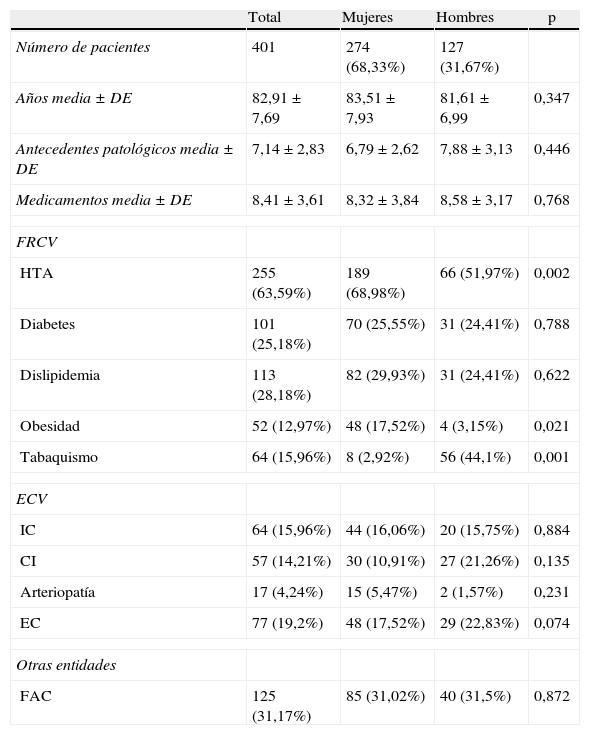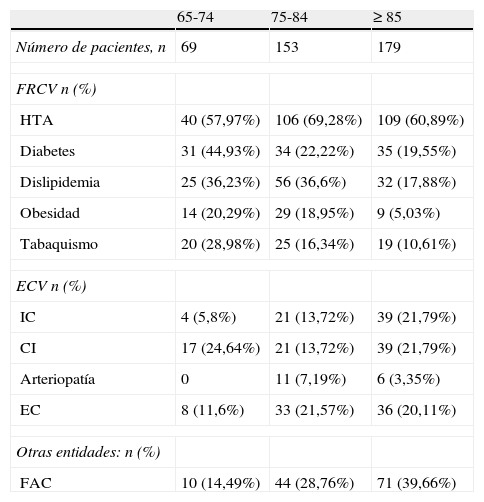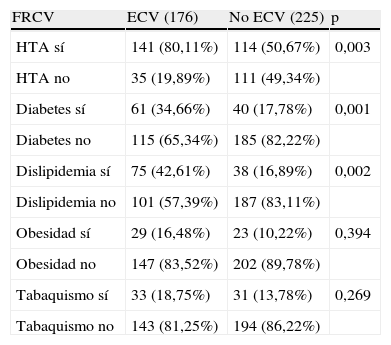Estudiar la prevalencia de los factores de riesgo cardiovascular (FRCV) y de enfermedad cardiovascular (ECV) de la población anciana ingresada en un centro sociosanitario y valorar su distribución por grupos de edad y por sexo.
Material y métodosEstudio descriptivo retrospectivo de los pacientes ≥65 años ingresados en un centro sociosanitario desde el 1de enero de 2009 al 31de diciembre de 2010. Los datos de prevalencia se obtuvieron de los antecedentes personales y/o toma de medicación crónica que constaban en la historia clínica.
ResultadosIngresaron 401 pacientes ≥65 años. Edad media 82,91±7,69 años. El 68,33% fueron mujeres. Los pacientes presentaron 7,14±2,83 antecedentes patológicos de media, siendo los más frecuentes los del aparato cardiovascular.
El 79,9% de los pacientes presentaron FRCV; 35,41% un FRCV; 27,27% 2 FRCV; 13,4% 3 FRCV y 3,83% 4 FRCV. Se presentaron de la siguiente manera: hipertensión arterial 63,59%; tabaquismo 15,96%; dislipidemia 28,18%; diabetes 25,18% y obesidad 12,97%. Por sexos (mujer/hombre, en %): HTA 68,98/51,97; tabaquismo 2,92/44,1; dislipidemia 29,93/24,41; diabetes 25,55/24,41; obesidad 17,52/3,15.
El 44,02% de los pacientes presentaba ECV: 34,91% de pacientes una ECV; 7,18% 2 ECV y 1,43% 3 ECV. Se distribuyeron: enfermedad cerebrovascular 19,2%; cardiopatía isquémica 14,21%; arteriopatía periférica 4,24%; insuficiencia cardiaca 15,96%. Por sexos (mujer/hombre, en%): enfermedad cerebrovascular 17,52/22,83; cardiopatía isquémica 10,91/21,26; arteriopatía periférica 5,47/1,57; insuficiencia cardiaca 16,06/15,75.
ConclusionesLa mayoría de los pacientes ingresados fueron mujeres.
El FRCV más prevalente fue la HTA (63,59%). La ECV más frecuente fue la enfermedad cerebrovascular (19,2%). Los pacientes con ECV presentaron más FRCV.
Las mujeres presentaron más FRCV que los hombres, excepto tabaquismo, y más insuficiencia cardiaca y arteriopatía periférica. Los hombres presentaron más cardiopatía isquémica y enfermedad cerebrovascular.
To determine prevalence of cardiovascular risk factors (CVRF) and cardiovascular disease (CVD) of the elderly population admitted to a geriatric center and to evaluate its distribution by age and sex groups.
Material and methodsA retrospective descriptive study of patients over 65 years admitted to a geriatric center from January 1, 2009, to December 31, 2010 was performed. Prevalence data were obtained from the patient's medical record regarding personal data and/or taking of chronic medication.
ResultsA total of 401 patients (68.3% women) over 65 years, mean age 82.91±7.69 years, were admitted. Mean disease background found was 7.14±2.83, those of the cardiovascular system being more frequent.
CVRF was found in 79.9%: 35.41% patients 1 CVRF, 27.27% 2 CVRF, 13.4% 3 CVRF and 3.83% 4 CVRF. These presented as: hypertension 63.59%, smoking 15.96%, dyslipidemia 28.18%, diabetes 25.18% and obesity 12.97%. By gender (female/male, in %): hypertension 69.98/51.97, smoking 2.92/44.1, dyslipidemia 29.93/24.41, diabetes 25.55/24.41, obesity 17.52/3.15.
CVD was found in 44.02% of patients: 34.91% 1 CVD, 7.18% 2 CVD and 1.43% 3 CVD. These were distributed as: cerebrovascular disease 19.2%, ischemic heart disease 14.21%, peripheral arterial disease 4.24% and heart failure 15.96%. By gender (female/male, in %): cerebrovascular disease 17.52/22.83, ischemic heart disease 10.91/21.26, peripheral arterial disease 5.47/1.57, heart failure 16.06/15.75.
ConclusionsMost patients admitted were women.
The most prevalent CVRF was hypertension (63.59%). The most frequent CVD was cerebrovascular disease (19.2%). More CVRF were presented in patients with CVD.
Women had a higher prevalence of CVRF than men, except smoking, and more heart failure and peripheral arterial disease. Men had more ischemic heart disease and cerebrovascular disease.
Artículo
Comprando el artículo el PDF del mismo podrá ser descargado
Precio 19,34 €
Comprar ahora








